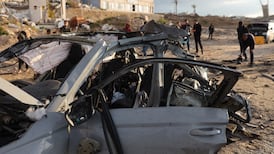The UN Relief and Works Agency (Unwra) has condemned a triple bombing at the Saida Zeinab suburb of Damascus on Sunday that killed 90 civilians and 40 security personnel and wounded 150.
Among the dead were 31 Palestinian refugees; 28 others were injured, all civilians dwelling in Unwra’s Qabr Essit camp. The near simultaneous explosions occurred at a popular marketplace near three primary schools in session, and children were among the victims.
The Islamic State terrorist group, which has repeatedly targeted the area, claimed the attack. A twin suicide bombing by the group – also known as Isis – killed another 71 in Saida Zeinab on January 31st this year as representatives of the government and the Saudi-sponsored opposition were in Geneva for UN-brokered talks that were suspended. Isis was accused of trying to scupper the talks.
Suicide bombers
Earlier attacks on Saida Zeinab were claimed by
Jabhat al-Nusra
. In February 2015 suicide bombers killed four people at a checkpoint near a revered Shia shrine and an explosion on a bus killed nine Lebanese pilgrims on the road to Saida Zeinab. In October 2012 an attack left six dead and a bomb in June damaged a mausoleum.
Jabhat al-Nusra, an offshoot of al-Qaeda in Iraq, entered the Syrian conflict with suicide bombings in Damascus in December 2011 and January 2012. Nusra's rival, Isis, crossed from Iraq into Syria during the spring of 2013. In response to the 2012 strikes, Saida Zeinab residents established a local guard which was reinforced by Iraqi volunteers in a group called Abu Fadl al-Abbas and by fighters from Lebanon's Hizbullah who had become embroiled in the conflict when armed Syrian factions attacked Syrian Shia villages near the Lebanese frontier.
Sunni radicals
Both these groups have been drawn into the wider Syrian conflict on the side of the secular government, while the majority of its antagonists became Sunni radicals who consider Shias heretics or apostates.
Saida Zeinab takes its name from the tomb of the revered granddaughter of the Prophet Muhammad. The tomb has been enclosed in a golden domed Shia shrine, once a place of pilgrimage by hundreds of thousands of Shias from Iran, Iraq, Lebanon, Afghanistan, India and Pakistan.
Saida Zeinab has also been a sanctuary for refugees other than Palestinians who first settled there following the 1948 Israeli-Arab war and flooded into Syria after Israel’s 1967 occupation of the West Bank and Syrian Golan.
Following the 1991 and 2003 US wars on Iraq, tens of thousands of Shia Iraqis flocked to Saida Zeinab where they established their own neighbourhoods distinguished by Iraqi cafes, food stalls, and tanks of Euphrates carp for grilling on wooden planks, “masgouf,” a favourite Iraqi dish.
When Saida Zeinab became a frontline in the war, Iraqis either moved into Damascus or returned to unsettled Iraq. Sunni Syrians and Palestinians fleeing insurgent conquests of their villages southeast of Damascus took refuge in Saida Zeinab, seeking the protection of Abu Fadl al-Abbas and Hizbullah which, along with other Iraqi Shia militias , have become close allies of the regular Syrian army .












